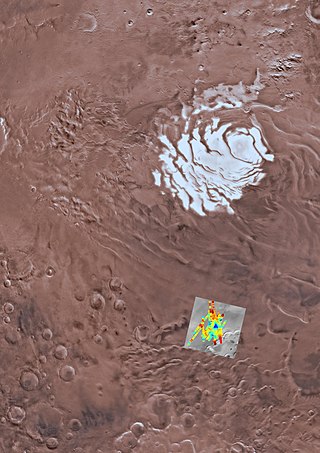Related Research Articles

Lake Vostok is the largest of Antarctica's 675 known subglacial lakes. Lake Vostok is located at the southern Pole of Cold, beneath Russia's Vostok Station under the surface of the central East Antarctic Ice Sheet, which is at 3,488 m (11,444 ft) above mean sea level. The surface of this fresh water lake is approximately 4,000 m (13,100 ft) under the surface of the ice, which places it at approximately 500 m (1,600 ft) below sea level.

An iceberg is a piece of freshwater ice more than 15 m long that has broken off a glacier or an ice shelf and is floating freely in open water. Smaller chunks of floating glacially derived ice are called "growlers" or "bergy bits". Much of an iceberg is below the water's surface, which led to the expression "tip of the iceberg" to illustrate a small part of a larger unseen issue. Icebergs are considered a serious maritime hazard.

The Byrd Polar and Climate Research Center (BPCRC) is a polar, alpine, and climate research center at Ohio State University founded in 1960.

A subglacial lake is a lake that is found under a glacier, typically beneath an ice cap or ice sheet. Subglacial lakes form at the boundary between ice and the underlying bedrock, where pressure decreases the pressure melting point of ice. Over time, the overlying ice gradually melts at a rate of a few millimeters per year. Meltwater flows from regions of high to low hydraulic pressure under the ice and pools, creating a body of liquid water that can be isolated from the external environment for millions of years.

Thwaites Glacier is an unusually broad and vast Antarctic glacier located east of Mount Murphy, on the Walgreen Coast of Marie Byrd Land. It was initially sighted by polar researchers in 1940, mapped in 1959–1966 and officially named in 1967, after the late American glaciologist Fredrik T. Thwaites. The glacier flows into Pine Island Bay, part of the Amundsen Sea, at surface speeds which exceed 2 kilometres (1.2 mi) per year near its grounding line. Its fastest-flowing grounded ice is centered between 50 and 100 kilometres east of Mount Murphy. Like many other parts of the cryosphere, it has been adversely affected by climate change, and provides one of the more notable examples of the retreat of glaciers since 1850.
Whillans Ice Stream is a glaciological feature of the West Antarctic Ice Sheet, formerly known as Ice Stream B, renamed in 2001 in honor of Ohio State University glaciologist Ian Whillans.

Totten Glacier is a large glacier draining a major portion of the East Antarctic Ice Sheet, through the Budd Coast of Wilkes Land in the Australian Antarctic Territory. The catchment drained by the glacier is estimated at 538,000 km2 (208,000 sq mi), extending approximately 1,100 km (680 mi) into the interior and holds the potential to raise sea level by at least 3.5 m (11 ft). Totten drains northeastward from the continental ice but turns northwestward at the coast where it terminates in a prominent tongue close east of Cape Waldron. It was first delineated from aerial photographs taken by USN Operation Highjump (1946–47), and named by Advisory Committee on Antarctic Names (US-ACAN) for George M. Totten, midshipman on USS Vincennes of the United States Exploring Expedition (1838–42), who assisted Lieutenant Charles Wilkes with correction of the survey data obtained by the expedition.
There are hundreds of antarctic lakes in Antarctica. In 2018 researchers at the Alfred Wegener Institute for Polar and Marine Research published a study they claimed cast doubt on the earlier estimate that there were almost 400 subglacial antarctic lakes. Antarctica also has some relatively small regions that are clear of ice and snow, and there are some surface lakes in these regions. They called for on the ground seismic studies, or drilling, to determine a more reliable number.

Lake Whillans is a subglacial lake in Antarctica. The lake is located under the Whillans Ice Stream at the southeastern edge of the Ross Ice Shelf in the west of the continent. The lake surface is 800 m (2,600 ft) beneath the surface of the ice and the lake covers an estimated area of 60 km2 (20 sq mi). Lake depths measured thus far have been around 2 metres. Its temperature is −0.49 °C, below 0 °C because of the high pressure.
Lake CECs is a subglacial lake in Antarctica at approximately latitude 80°S. It has an estimated area of 18 km2. The territory where the lake is located, some 160 km from Union Glacier, is claimed only by Chile.

Jemma L Wadham is a British glacial biogeochemist.

Liu Yan is a Chinese Antarctic researcher best known for her work on iceberg calving. She is an associate professor of geography in the College of Global Change and Earth System Science (GCESS) and Polar Research Institute, Beijing Normal University.

Cristina Takacs-Vesbach is an American microbial ecologist conducting research on the productivity, diversity, and function of microbial communities living at the two extremes of temperature found on Earth-Antarctica's McMurdo Dry Valleys and Yellowstone National Park's thermal springs.

Trista Vick-Majors is an American Assistant Professor in Biological Sciences at Michigan Tech. She is an Antarctic biogeochemist and microbial ecologist, best known for her work showing that microorganisms are present under the Antarctic ice sheet.
Martin J. Siegert is a British glaciologist, and Deputy Vice Chancellor (Cornwall) at the University of Exeter. He co-Chairs the Diversity in Polar Science Initiative, and has spoken about socio-economic inclusion in Polar Science and indeed broader society.
Sophie Marie Jeanne Nowicki, is Empire Innovation Professor in the Department of Geology of the University at Buffalo. She does research on the Greenland and Antarctic ice sheets, focusing on their connections to global climate and sea level. Before that, she was physical scientist at the Nasa Goddard Space Flight Centre, investigating ice sheet changes.
Mercer Subglacial Lake is a subglacial lake in Antarctica covered by a sheet of ice 1,067 m (3,501 ft) thick; the water below is hydraulically active, with water replacement times on the order of a decade from the Ross Sea. Studies suggest that Mercer Subglacial Lake as well as other subglacial lakes appear to be linked, with drainage events in one reservoir causing filling and follow-on drainage in adjacent lakes.

Salty subglacial lakes are controversially inferred from radar measurements to exist below the South Polar Layered Deposits (SPLD) in Ultimi Scopuli of Mars' southern ice cap. The idea of subglacial lakes due to basal melting at the polar ice caps on Mars was first hypothesized in the 1980s. For liquid water to persist below the SPLD, researchers propose that perchlorate is dissolved in the water, which lowers the freezing temperature, but other explanations such as saline ice or hydrous minerals have been offered. Challenges for explaining sufficiently warm conditions for liquid water to exist below the southern ice cap include low amounts of geothermal heating from the subsurface and overlying pressure from the ice. As a result, it is disputed whether radar detections of bright reflectors were instead caused by other materials such as saline ice or deposits of minerals such as clays. While lakes with salt concentrations 20 times that of the ocean pose challenges for life, potential subglacial lakes on Mars are of high interest for astrobiology because microbial ecosystems have been found in deep subglacial lakes on Earth, such as in Lake Whillans in Antarctica below 800 m of ice.
Sinéad Louise Farrell is a British-American space scientist who is Professor of Geographic Sciences at the University of Maryland, College Park. Her research considers remote sensing and climate monitoring. She was science lead for the ICESat-2 Mission, which used laser altimetry to make height maps of Earth.

Catherine Walker is an American Earth and planetary scientist at the Woods Hole Oceanographic Institution, where she is on the scientific staff in the Department of Applied Ocean Physics and Engineering. Her research spans fracture mechanics and dynamics in ice, cryosphere change, physical oceanography, and geomorphology on Earth and other planets and moons using a variety of methodologies including remote sensing.
References
- 1 2 "The Antarctic Sun: News about Antarctica – Taking the Prize". antarcticsun.usap.gov. Retrieved 2016-05-30.
- 1 2 "Bio". Research Profiles. Retrieved 2016-05-30.
- ↑ Gewin, Virginia (2010-09-15). "Helen Amanda Fricker". Nature. 467 (7313): 359. doi: 10.1038/nj7313-359a .
- ↑ "Research Profiles". Research Profiles. Retrieved 2016-05-30.
- ↑ "Publications". glaciology.weebly.com. Retrieved 2016-05-30.
- ↑ Fricker, Helen Amanda; Scambos, Ted; Bindschadler, Robert; Padman, Laurie (2007-03-16). "An Active Subglacial Water System in West Antarctica Mapped from Space". Science. 315 (5818): 1544–1548. Bibcode:2007Sci...315.1544F. doi:10.1126/science.1136897. PMID 17303716. S2CID 35995169.
- 1 2 Kaufman, Marc (5 February 2013). "Life Found Deep Under Antarctic Ice for First Time?". National Geographic Daily News. Archived from the original on February 7, 2013. Retrieved 2013-02-20.
- 1 2 "Projects". glaciology.weebly.com. Retrieved 2016-05-30.
- ↑ "Personnel | WISSARD". www.wissard.org. Retrieved 2016-05-30.
- ↑ Fox, Douglas (2014-08-21). "Lakes under the ice: Antarctica's secret garden". Nature. 512 (7514): 244–246. Bibcode:2014Natur.512..244F. doi: 10.1038/512244a . PMID 25143097.
- ↑ Amos, Jonathan (28 January 2013). "Drill reaches Antarctica's under-ice Lake Whillans". BBC . Retrieved 22 June 2016.
- ↑ "People". Scripps Polar Center. 2019-05-09. Retrieved 2020-01-30.
- ↑ "Latest Additions to BAT Gazetteer". Antarctic Place-names Committee. British Antarctic Survey - NERC. Retrieved 5 December 2020.
- ↑ "Past Recipients". rst.org.au. Retrieved 2016-05-30.
- ↑ "NASA – Biographies". www.nasa.gov. Retrieved 2016-05-30.
- ↑ "Tinker-Muse Prize for Science and Policy in Antarctica". www.museprize.org. Archived from the original on 2017-09-14. Retrieved 2016-05-30.
- ↑ "Scripps Glaciologist Awarded 2010 Muse Prize for Science and Policy in Antarctica | Scripps Institution of Oceanography, UC San Diego". scripps.ucsd.edu. Retrieved 2016-05-30.
- ↑ "Fellows Winner Search". Honors Program. Retrieved 2018-12-15.